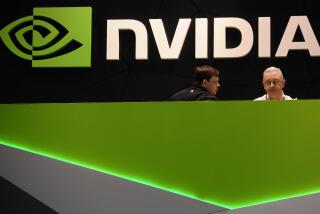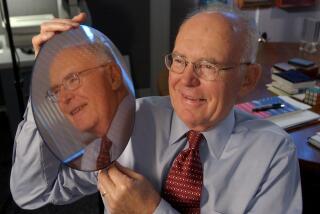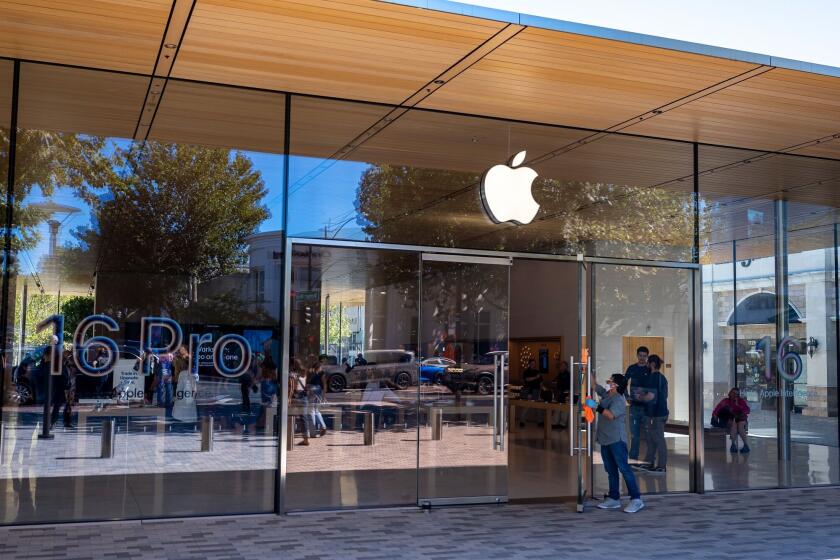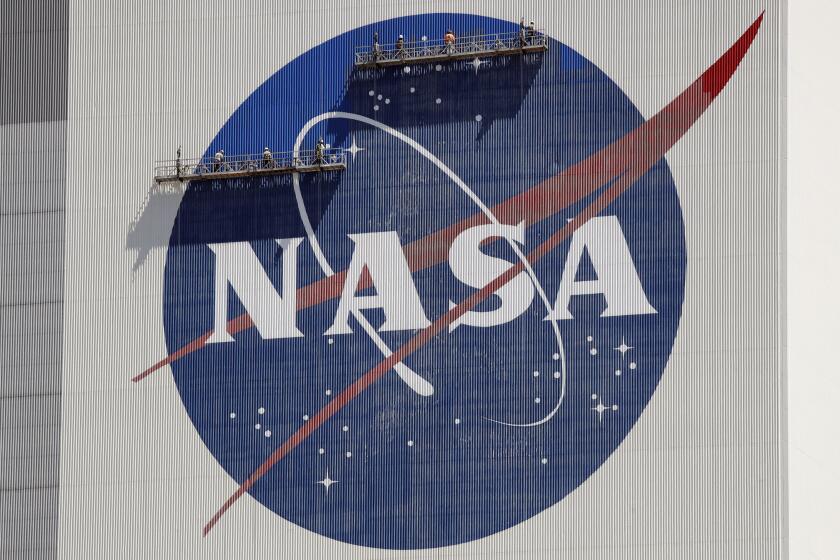3 Companies Put Silicon Behind, Bet on New Chip
- Share via
In a low-lying sandy area about 300 miles south of Silicon Valley, the symbol of Northern California’s dominance in the high-technology business, commercial applications are being developed for a semiconductor material even more versatile than silicon. It’s called gallium arsenide.
Three infant companies in this stretch of Ventura County between Simi Valley and Camarillo are working frantically to produce gallium arsenide chips, which operate at high frequencies, allowing computers to work faster than they would with silicon chips.
The companies--GigaBit Logic of Newbury Park, Vitesse Electronics of Camarillo and Microwave Monolithics of Simi Valley--all are headed by alumni of defense giant Rockwell International.
Only GigaBit has begun selling the chips, and all three companies are a long way from making a profit. But these engineers-turned-entrepreneurs envision their compound replacing silicon in a number of products within 10 years.
‘Gallium Gulch’
They see their corner of the world as the future hub of high-tech growth--a “Gallium Gulch” as some call it--Southern California’s answer to Silicon Valley.
But there are big obstacles. Silicon, an excellent conductor of electrons that has made the boom in microelectronics possible, is a naturally occurring element found in abundance in ordinary sand. Gallium, on the other hand, is a rare element, and must be processed with arsenic to produce gallium arsenide.
As a consequence, gallium arsenide costs from 3 to 10 times what silicon does--up to $200 for a single gallium arsenide wafer. Because of the price, even optimistic forecasts for gallium arsenide are that, by 1995, it will take no more than 20% of the worldwide semiconductor market, projected to be about $65 billion.
In the race for that business, “the pack is still bunched together, but probably not for too long,” said Ted Wakayama, director of the semiconductor group for Strategic Inc., a Northern California-based market research firm that specializes in electronics. “The industry is new. No one’s got the market cornered,” he said.
Military Uses
Gallium arsenide has been developed primarily for military uses, including high-frequency microwave radio, radar and satellite communications. Rockwell International, Hughes Aircraft, AT&T; and Hewlett-Packard all have been researching and making gallium arsenide chips for years, but have not marketed it, largely because of the cost.
Rockwell has 100 people at its new $16-million pilot production plant in Newbury Park, part of its Microelectronics Research and Development Center. The company is exploring military applications exclusively, including use of gallium arsenide chips for military computers.
The director of the center, Gene Pentecost, described the departure of Rockwell executives to open gallium arsenide companies as the “Silicon Valley syndrome.”
“It’s the entrepreneurial spirit,” Pentecost said. “If our guys want to go out on their own, that’s fine. We just want them to respect our proprietary rights.”
Rockwell Files Suit
In fact, Rockwell filed suit against Vitesse Electronics last September, accusing the company of taking equipment lists and “fomenting employee problems at Rockwell.” A Vitesse official said the suit actually was prompted by its recruitment of one key Rockwell executive, and that it is not worried about the case.
Aside from GigaBit, only Harris Microwave Semiconductor in the Silicon Valley community of Milpitas produces gallium arsenide chips commercially. The 5-year-old subsidiary of Harris Corp. started selling its chips in February, 1984, mostly for use in communications. A Ford Motor subsidiary that already makes silicon-based chips for cars and trucks recently announced plans for what would be the first high-volume gallium-arsenide factory, in Colorado Springs.
Other stiff competition will likely come from Japanese companies--including Fujitsu, Hitachi and NEC--which already are leading in laboratory production, but are not yet producing chips commercially.
Two of the Gallium Gulch companies, GigaBit and Vitesse, are competing head to head to make digital circuitry, which provides the memory and logic functions in computers. Microwave Monolithics is focusing more on microwave circuits, used primarily for high-frequency communications such as are needed in satellites and radar.
Speedier Computers
The future of GigaBit and Vitesse may lie in the so-called supercomputer market, where silicon has reached its speed limit. Supercomputers are much faster than standard computers.
GigaBit’s name comes from the prefix for billion; one gigahertz is a billion cycles per second. Vitesse means speed in French.
Minneapolis-based Cray Research, the leading manufacturer of the new generation of supercomputers, is using GigaBit’s gallium arsenide chips to power its Cray-3. Those computers are expected to be running with gallium arsenide components by 1987.
GigaBit was formed in 1981 by Fred A. Blum and Richard C. Eden, former Rockwell executives. Blum headed gallium arsenide research at Rockwell’s laboratories in Anaheim, and Eden worked for the company in Thousand Oaks.
Unable to convince their superiors to produce gallium arsenide commercially, Blum and Eden set off on their own.
“We’ve had to be careful not to bring big-defense-contractor thinking into an entrepreneurial situation,” said Blum, GigaBit’s president and chairman. “We have to be more creative with our sales and marketing.”
$30 Million Raised
The privately held company was started with $30 million raised from several sources, including Standard Oil of Indiana and Analog Devices, makers of electronic components in Norwood, Mass.
GigaBit has invested more than $10 million in equipment at its 22,000-square-foot Newbury Park plant, which employs 110. GigaBit has signed up 200 customers since it began selling its chips in June, 1984.
Although GigaBit will not release sales figures, Blum said he aims at annual sales of $100 million by 1987. The company likely will go public before the end of this year, he said.
Blum said he’s not too worried about competition. “The market is so new, I don’t mind other companies helping to develop it for us,” Blum said. “Of course I’ll be a little less generous in two to four years.”
GigaBit probably will maintain its lead over rivals because of its head start, said Dan Love, a partner at the Woodland Hills office of Arthur Young & Co., the accounting firm.
Will Make Computers, Too
Vitesse Electronics, however, has a plan for developing its own niche. Rather than manufacturing only gallium arsenide chips, Vitesse also will make high-speed computers, which it hopes to start selling by early 1987.
The computers will be equipped with silicon components at first, but they will have plug-in circuit boards so they can be easily converted to gallium arsenide components.
The company was founded 13 months ago by Alfred S. Joseph, former senior engineering executive for Rockwell. Much of its financing came from Norton Co., an industrial conglomerate in Worcester, Mass., which acquired 50% of Vitesse for $30 million.
“We weren’t that interested in raising the money initially,” said Joseph, Vitesse president and chief executive officer. “Our concern was what we would do with the money, and how we could translate the things we know how to do into a viable company that would attract good people with secure jobs.”
Rockwell Alumni
Like GigaBit, Vitesse brought aboard a number of former Rockwell executives. For example, Louis R. Tomasetta, president for integrated circuits, was director of the advanced technology implementation department at Rockwell’s Microelectronics Research and Development Center.
Vitesse now employs 80 people, all shareholders in the company. Processing equipment is just now rolling into the company’s Camarillo plant. Joseph said sample chips will be available from his plant before the end of the year.
Microwave Monolithics was formed in 1982 by former Rockwell executive Daniel Ch’en. The company, closely aligned with big defense contractors, is aiming to develop gallium arsenide chips for use in microwave broadcasting.
A major military use of gallium arsenide is in components aboard military planes that help the planes avoid detection. The components can receive radar signals from an enemy, distort them, then send them back so the enemy gets incorrect information about the plane’s location.
Microwave Monolithics employs about 15 in its Simi Valley offices. The company is backed by its proprietors, including Ch’en, without any help from venture capital groups, said Wendell Petersen, an engineer with the company.
Microwave Monolithics originally had intended to move heavily into products for home television reception of satellite signals but may not pursue that because of a weakening of that industry, Petersen said.
“We can’t sell our receivers if there are no satellites floating around,” he said. THE MARKET FOR GALLIUM ARSENIDE
Gallium arsenide, a dark-gray crystalline compound, can be used in transistors, solar cells and lasers. It is more efficient than silicon and is expected to take a fast-growing share of the semiconductor market worldwide.
1984
$50 million
Military
$37.5
Computers
$4.0
Communications
$6.0
Industrial Instruments
$2.5
(in millions)
1994 $13 billion (projected)
Computers
$4.55
Military
$2.34
Communications
$2.6
Consumer Products
$1.17
Industrial Instruments
$2.34
(in billions)
Source: Strategic Inc.
More to Read
Inside the business of entertainment
The Wide Shot brings you news, analysis and insights on everything from streaming wars to production — and what it all means for the future.
You may occasionally receive promotional content from the Los Angeles Times.










